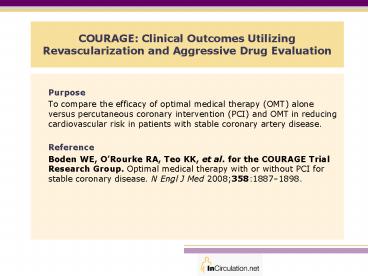COURAGE: Clinical Outcomes Utilizing Revascularization and Aggressive Drug Evaluation - PowerPoint PPT Presentation
1 / 8
Title:
COURAGE: Clinical Outcomes Utilizing Revascularization and Aggressive Drug Evaluation
Description:
COURAGE: Clinical Outcomes Utilizing Revascularization and Aggressive Drug Evaluation ... Boden WE, O'Rourke RA, Teo KK, et al. for the COURAGE Trial Research Group. ... – PowerPoint PPT presentation
Number of Views:67
Avg rating:3.0/5.0
Title: COURAGE: Clinical Outcomes Utilizing Revascularization and Aggressive Drug Evaluation
1
COURAGE Clinical Outcomes Utilizing
Revascularization and Aggressive Drug Evaluation
- Purpose
- To compare the efficacy of optimal medical
therapy (OMT) alone versus percutaneous coronary
intervention (PCI) and OMT in reducing
cardiovascular risk in patients with stable
coronary artery disease. - Reference
- Boden WE, ORourke RA, Teo KK, et al. for the
COURAGE Trial Research Group. Optimal medical
therapy with or without PCI for stable coronary
disease. N Engl J Med 200835818871898.
2
COURAGE Clinical Outcomes Utilizing
Revascularization and Aggressive Drug
Evaluation- TRIAL DESIGN -
- Design
- Multicenter, prospective, randomized trial.
- Patients
- 2287 patients who had either stable coronary
artery disease (CAD) or Canadian Cardiovascular
Society (CCS) class IV angina that had
subsequently stabilized. - Exclusion criteria included persistent CCS class
IV angina, refractory heart failure or
cardiogenic shock, classic angina, ejection
fraction of lt30, revascularization within the
previous 6 months, and coronary anatomy not
suitable for PCI. - Primary and secondary endpoints
- The primary endpoint was a composite of
all-cause mortality and non-fatal myocardial
infarction (MI) during a follow-up period of
2.57.0 years. - Secondary endpoints included non-fatal MI,
hospitalization for acute coronary syndrome, and
a composite of death, MI and stroke.
3
COURAGE Clinical Outcomes Utilizing
Revascularization and Aggressive Drug
Evaluation- TRIAL DESIGN continued -
- Treatment
- For OMT, all patients received aspirin (81325
mg/day) or clopidogrel (75 mg/day). All patients
received simvastatin alone or in combination with
ezetimibe to reduce LDL-cholesterol levels
(target of 1.552.220 mmol/L). - Exercise, fibrates and/or extended release
niacin were used to raise HDL-cholesterol levels
(target 1.03 mmol/L) and to reduce triglyceride
levels (target of 1.69 mmol/L). - PCI OMT
- In addition to OMT, complete revascularization
was performed as necessary, and target-lesion
revascularization was attempted when appropriate. - Patients undergoing PCI received aspirin or
clopidogrel in accordance with the guidelines. - Other therapeutic considerations
- Both groups received anti-ischemic therapy
(metoprolol, amlodipine and/or isosorbide
mononitrate) with lisinopril or losartan.
4
COURAGE Clinical Outcomes Utilizing
Revascularization and Aggressive Drug Evaluation
- TRIAL DESIGN continued -
Baseline characteristics
OMT PCI
OMT
(n1138)
(n1149)
Mean age - years
61.5
61.8
Male - number ()
979 (85)
968 (85)
Angina CCS class ()
0
135 (12)
148 (13)
I
340 (30)
341 (30)
II
409 (36)
425 (37)
III
261 (23)
221 (19)
History number ()
Hypertension
757 (66)
764 (67)
367 (32)
Diabetes
399 (35)
Congestive heart failure
57 (5)
51 (4)
Cerebrovascular disease
100 (9)
102 (9)
Myocardial infarction
437 (38)
439 (39)
Previous PCI
174 (15)
185 (16)
Vessels with disease ()
361 (31)
343 (30)
One
446 (39)
Two
439 (39)
Three
341 (30)
355 (31)
Proximal LAD disease ()
360 (31)
417 (37)
Ejection fraction
60.8
60.9
Boden et al. N Eng J Med 2007356114.
5
COURAGE Clinical Outcomes Utilizing
Revascularization and Aggressive Drug Evaluation
- RESULTS -
- Primary endpoint and follow-up
- At 4.6 years, the estimated cumulative primary
event rates were 19.0 in the PCI OMT group,
and 18.5 in the OMT group (unadjusted hazard
ratio HR in PCI group, 1.05 95 confidence
interval CI, 0.871.27 p0.62). - Secondary endpoints
- There were no significant differences between
the PCI OMT group and the OMT group in terms of
the following - Composite of death, myocardial infarction and
stroke (20 vs. 19.5, respectively HR, 1.05
95 CI, 0.871.27 p0.62) - Hospitalization for acute coronary syndromes
(12.4 vs. 11.8, respectively HR, 1.07 95 CI
0.841.37 p0.56) - Myocardial infarction (13.2 vs. 12.3,
respectively HR, 1.13 95 CI, 0.891.43
p0.33) - Subgroup analysis
- The primary endpoint was similar across both
groups in patients with multivessel CAD, previous
MI and diabetes.
6
COURAGE Clinical Outcomes Utilizing
Revascularization and Aggressive Drug Evaluation
- RESULTS continued -
Kaplan-Meier survival curves
PCI
Medical therapy
No. at risk Medical therapy PCI
Boden et al. N Eng J Med 2007356114.
7
COURAGE Clinical Outcomes Utilizing
Revascularization and Aggressive Drug Evaluation
- RESULTS continued -
Secondary endpoints
PCI OMTn1149
OMTn1149
Hazard ratio(95 CI)
p value
Hospitalization for acutecoronary syndromes
HR, 1.07(95 CI, 0.841.37)
12.4
11.8
0.56
HR, 0.87(95 CI, 0.651.16)
Death alone
0.38
7.6
8.3
HR, 1.56(95 CI, 0.803.04)
Stroke alone
0.19
2.1
1.8
HR, 1.13(95 CI, 0.891.43)
Total non-fatal MI
0.33
13.2
12.3
HR, 0.60(95 CI, 0.510.71)
Revascularization (PCI or CABG)
21.1
32.6
lt0.001
Patients free from angina at5 years follow-up
74
72
0.35
Data indicate percentages of patients.
Boden et al. N Eng J Med 2007356114.
8
COURAGE Clinical Outcomes Utilizing
Revascularization and Aggressive Drug Evaluation
- SUMMARY -
- Compared with OMT alone, PCI OMT did not
reduce the primary composite endpoints of
all-cause mortality and non-fatal MI, and it did
not reduce the incidence of major cardiovascular
events. - In terms of secondary endpoints, there was no
significant difference between the groups. - However, PCI OMT did reduce the occurrence of
angina in comparison with OMT alone. - The results of this study are in agreement with
the guidelines stating that PCI can be safely
conducted in patients with stable coronary artery
disease, provided that aggressive medical therapy
is also maintained.































